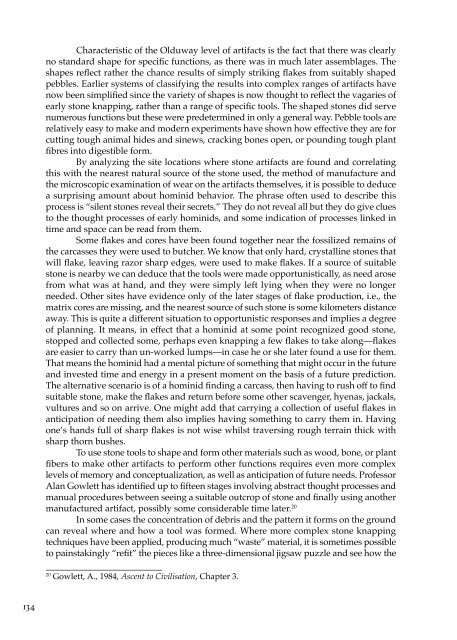The Spirit in Human Evolution - Waldorf Research Institute
The Spirit in Human Evolution - Waldorf Research Institute
The Spirit in Human Evolution - Waldorf Research Institute
Create successful ePaper yourself
Turn your PDF publications into a flip-book with our unique Google optimized e-Paper software.
Characteristic of the Olduway level of artifacts is the fact that there was clearly<br />
no standard shape for specific functions, as there was <strong>in</strong> much later assemblages. <strong>The</strong><br />
shapes reflect rather the chance results of simply strik<strong>in</strong>g flakes from suitably shaped<br />
pebbles. Earlier systems of classify<strong>in</strong>g the results <strong>in</strong>to complex ranges of artifacts have<br />
now been simplified s<strong>in</strong>ce the variety of shapes is now thought to reflect the vagaries of<br />
early stone knapp<strong>in</strong>g, rather than a range of specific tools. <strong>The</strong> shaped stones did serve<br />
numerous functions but these were predeterm<strong>in</strong>ed <strong>in</strong> only a general way. Pebble tools are<br />
relatively easy to make and modern experiments have shown how effective they are for<br />
cutt<strong>in</strong>g tough animal hides and s<strong>in</strong>ews, crack<strong>in</strong>g bones open, or pound<strong>in</strong>g tough plant<br />
fibres <strong>in</strong>to digestible form.<br />
By analyz<strong>in</strong>g the site locations where stone artifacts are found and correlat<strong>in</strong>g<br />
this with the nearest natural source of the stone used, the method of manufacture and<br />
the microscopic exam<strong>in</strong>ation of wear on the artifacts themselves, it is possible to deduce<br />
a surpris<strong>in</strong>g amount about hom<strong>in</strong>id behavior. <strong>The</strong> phrase often used to describe this<br />
process is “silent stones reveal their secrets.” <strong>The</strong>y do not reveal all but they do give clues<br />
to the thought processes of early hom<strong>in</strong>ids, and some <strong>in</strong>dication of processes l<strong>in</strong>ked <strong>in</strong><br />
time and space can be read from them.<br />
Some flakes and cores have been found together near the fossilized rema<strong>in</strong>s of<br />
the carcasses they were used to butcher. We know that only hard, crystall<strong>in</strong>e stones that<br />
will flake, leav<strong>in</strong>g razor sharp edges, were used to make flakes. If a source of suitable<br />
stone is nearby we can deduce that the tools were made opportunistically, as need arose<br />
from what was at hand, and they were simply left ly<strong>in</strong>g when they were no longer<br />
needed. Other sites have evidence only of the later stages of flake production, i.e., the<br />
matrix cores are miss<strong>in</strong>g, and the nearest source of such stone is some kilometers distance<br />
away. This is quite a different situation to opportunistic responses and implies a degree<br />
of plann<strong>in</strong>g. It means, <strong>in</strong> effect that a hom<strong>in</strong>id at some po<strong>in</strong>t recognized good stone,<br />
stopped and collected some, perhaps even knapp<strong>in</strong>g a few flakes to take along—flakes<br />
are easier to carry than un-worked lumps—<strong>in</strong> case he or she later found a use for them.<br />
That means the hom<strong>in</strong>id had a mental picture of someth<strong>in</strong>g that might occur <strong>in</strong> the future<br />
and <strong>in</strong>vested time and energy <strong>in</strong> a present moment on the basis of a future prediction.<br />
<strong>The</strong> alternative scenario is of a hom<strong>in</strong>id f<strong>in</strong>d<strong>in</strong>g a carcass, then hav<strong>in</strong>g to rush off to f<strong>in</strong>d<br />
suitable stone, make the flakes and return before some other scavenger, hyenas, jackals,<br />
vultures and so on arrive. One might add that carry<strong>in</strong>g a collection of useful flakes <strong>in</strong><br />
anticipation of need<strong>in</strong>g them also implies hav<strong>in</strong>g someth<strong>in</strong>g to carry them <strong>in</strong>. Hav<strong>in</strong>g<br />
one’s hands full of sharp flakes is not wise whilst travers<strong>in</strong>g rough terra<strong>in</strong> thick with<br />
sharp thorn bushes.<br />
To use stone tools to shape and form other materials such as wood, bone, or plant<br />
fibers to make other artifacts to perform other functions requires even more complex<br />
levels of memory and conceptualization, as well as anticipation of future needs. Professor<br />
Alan Gowlett has identified up to fifteen stages <strong>in</strong>volv<strong>in</strong>g abstract thought processes and<br />
manual procedures between see<strong>in</strong>g a suitable outcrop of stone and f<strong>in</strong>ally us<strong>in</strong>g another<br />
manufactured artifact, possibly some considerable time later. 20<br />
In some cases the concentration of debris and the pattern it forms on the ground<br />
can reveal where and how a tool was formed. Where more complex stone knapp<strong>in</strong>g<br />
techniques have been applied, produc<strong>in</strong>g much “waste” material, it is sometimes possible<br />
to pa<strong>in</strong>stak<strong>in</strong>gly “refit” the pieces like a three-dimensional jigsaw puzzle and see how the<br />
_________________________<br />
20<br />
Gowlett, A., 1984, Ascent to Civilisation, Chapter 3.<br />
134
















